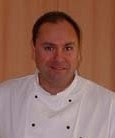Adelgisa is my friend Paolo's mother and she is the quintessential Italian "momma"... round and cherubic, she has fire in her eyes and cooks like an angel. I spent some time bent over her stove and this is what I walked away with.
First a few comments:
-This recipe seems rather basic but I assure you it makes your eyes roll.
-I don't use measurements because this dish is always cooked by feeling...
-Italians are not that hung up about the rice. Everyone has a favorite but most buy what ever is on sale. I have repeatedly asked opinions from people I respect and I get all sorts of answers, so use the risotto rice you like and have some experience with. Adelgisa used Roma, I think, but it isn't that important because the flavor will come from the stock and the meat and texture is a matter of timing.
Ok, lets start:
Melt some butter in a high-sided pan, add finely chopped shallots and fry them over medium heat without browning (a little salt will soften them quicker). When they are about half-way done, throw in some Salsiccia that has been removed from it's casing (an Italian sausage, Salsiccia means "salted fat" and it comes flavored (fennel, picante etc.) or plain. Use plain if you can get it. If in doubt, fine grind pork shoulder with a little extra fat and some salt and pepper to taste.
Break the pork into tiny-tiny bits and once the pork is cooked down add some of the rice and toast it lightly with the pork.
Add some bone dry white wine, she used Cortese, and let it be absorbed.
Add some stock. To my surprise (and horror) Adelgisa uses Maggi cubes, diluted and kept to a simmer on the back burner. Trust me here...Maggi cubes can work miracles in the right hands! Again...don't get too hung up on expensive ingredients.
Adelgisa is not the stirring type. She adds the broth a little at a time and quickly stirs, it in, then covers the pot and lets it sit over a low flame. Piano piano!
After about 13 minutes she checks the risotto. When she is happy with the texture, she turns off the burner (the rice should be a little under done) and adds some Parmesan cheese and a knob of butter, lets it sit for five minutes and dishes it out.
That's it.
Your results may vary because of the Salsiccia, but go slowly and make the recipe your own. You will find how it will work best for you. The ingredients will tell you what they need. Dial it in your own way and don't be upset if it doesn't blow your mind the first time, it will in time!
More about the rice:
Arborio doesn't really stand for much these days and you are better off chasing down a Carnaroli or Vialone Nano which are more likely to be found in a US/UK grocery store. I went to my local supermarket here in Asti and here is a pretty good list of what can be found here and some of the cooking times involved:
Europa: 15 min
Padano: 15 min
Ribe: 15 min
Carnaroli: 18 min
Vialone: 15 min
Roma: 14 min
Baldo: 18 min
Originario: 12 min
S. Andrea: 14 min
Superfino Arborio. 18 min
Please note cooking times can vary and you should begin tasting the rice frequently after 12-13 minutes over moderate heat. The rice should be slightly firm to the bite.


